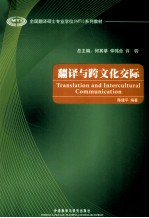

翻译与跨文化交际PDF格式文档图书下载
- 购买点数:10 点
- 作 者:陈建平编著 何其莘 仲伟合 许钧主编
- 出 版 社:北京:外语教学与研究出版社
- 出版年份:2012
- ISBN:9787513524476
- 标注页数:238 页
- PDF页数:254 页
Part 1 Intercultural Communication in Translation 翻译中的跨文化交际因素 1
1.1 The Interconnectedness Between Translation and Intercultural Communication 2
1.2 Approaches to Intercultural Communication Studies 3
1.2.1 The Scope of Intercultural Communication 3
1.2.2 The Rationale for Intercultural Communication Studies 5
1.2.3 Intercultural.Intracultural and Cross-cultural Communication 8
1.2.4 The Contextual Model and the Sociolinguistic Approach 10
1.3 The Themes of This Introductory Course 15
1.4 Workshop 17
1.4.1 Translation and Studies in Communication&Culture 17
1.4.2 The Problems of Translation and Equivalence 19
1.4.3 Translatability of Cultural Perspectives 25
1.4.4 Practice in Translating Culture 30
Suggested Readings 38
Part 2 Language and Communication 语言与交际 41
2.1 Understanding Communication 42
2.1.1 The Process of Communication 44
2.1.2 The Features of Human Communication 46
2.1.3 The Relationship Between Communication and Culture 49
2.1.4 Dimensions for Assessing Communicative Differences Across Cultures 51
2.2 Understanding Language and Communication 52
2.2.1 The Nature of Language as Communication 52
2.2.2 The Patterns and Functions of Communication 55
2.3 Understanding the Concept of Communicative Competence 57
2.3.1 Defining a Competent Communicator 57
2.3.2 Implications for Foreign Language Learning and Translation Practice 58
2.4 Workshop 63
2.4.1 Basic Notions in the Analysis 63
2.4.2 A Comparative Analysis of a Communicative Event Across Cultures 67
2.4.3 A Comparative Analysis of Bilingual Introductions to Universities in China 72
Suggested Readings 79
Part 3 Language and Culture 语言与文化 81
3.1 Understanding Culture 82
3.1.1 The Nature of Culture 82
3.1.2 The Basic Elements of Culture 85
3.2 Language and Cultural Thought Patterns 89
3.2.1 Language and Cultural Perception 89
3.2.2 Language and Thought Patterns 93
3.3 Language and Cultural Contexts 97
3.3.1 High-context Culture vs.Low-context Culture 98
3.3.2 Individualistic vs. Collectivistic Cultural Context 104
3.4 Workshop 109
3.4.1 Cultural Presuppositions 109
3.4.2 Differences in Cultural Presupposition 111
3.4.3 Structural Differences vs. Cultural Differences 115
3.4.4 An Illustration of Language and Context 121
3.4.5 Culture Shock 122
Suggested Readings 126
Part 4 Language and Society 语言与社会 129
4.1 Language and Language Varieties 130
4.1.1 Language and Variation 130
4.1.2 Language and Dialect 132
4.2 Language and Social Variation 135
4.2.1 Language and Social Backgrounds 135
4.2.2 Language and Occupation 140
4.3 Bilingualism and Multiculturalism 143
4.3.1 Monolingualism vs. Bilingualism 143
4.3.2 Multiculturalism 146
4.4 Workshop 148
4.4.1 Speech and Identity 148
4.4.2 Language and Gender 150
4.4.3 Language and Nation 155
4.4.4 The Language of Stock Exchanges 158
4.4.5 Multilingualism and Translation Problems in the European Union 162
Suggested Readings 167
Part 5 Intercultural Discourse 语篇与文化 169
5.1 Culture and Speech Acts 170
5.1.1 Communication and Speech Acts 170
5.1.2 Speech Acts and Culture 176
5.2 Culture and Politeness 180
5.2.1 The Notion of Face and Politeness Strategies 180
5.2.2 Politeness Strategies of Involvement and Independence 184
5.3 Culture and Discourse Patterns 187
5.3.1 Culture and Discourse Structure 187
5.3.2 Cultural Patterns of Rhetoric 192
5.4 Workshop 195
5.4.1 Different Cultures,Different Speech Act Sets 195
54.2 Chinese EFL Students' Characteristic Paragraph and Essay Structure 200
5.4.3 An Illustration of a Typical Chinese Discourse Pattern 207
5.4.4 A Comparison of New Year Messages 213
5.4.5 Discussion of the Application of the Notion of Genre in Translation 220
Suggested Readings 222
References 参考书目 225
- 《跨文化交际与翻译》陈静,高文梅,陈昕著 2017
- 《跨文化交际与翻译策略》张治英,朱勤芹著 2007
- 《语言·跨文化交际·翻译》冯艳昌主编;宁霞,匡晓文副主编 2012
- 《翻译与跨文化交际》陈建平编著;何其莘,仲伟合,许钧主编 2012
- 《跨文化交际与英汉翻译策略研究》谭焕新著 2018
- 《中日语言翻译与跨文化交际》王秀文主编 2006
- 《汉英跨文化交际翻译》金惠康著 1998
- 《跨文化交际视域下的翻译教学》苏辛欣著 2019
- 《跨文化交际与翻译 汉英语言文化比较》金惠康著 1997
- 《跨文化交际下的英汉翻译研究》胡蝶著 2018
- 《翻译与跨文化交际》陈建平编著;何其莘,仲伟合,许钧主编 2012
- 《会议口译》何其莘,仲伟合,许钧总主编姚斌,朱玉犇,孙婷婷编著 2016
- 《英语口译教程 下》仲伟合主编;仲伟合等编 2006
- 《汉英口译》仲伟合,何刚强主编;詹成,王斌华,伍志伟编著 2012
- 《宾馆英语》仲伟合编著;肖惠云主审 1994
- 《重读今日英国》仲伟合,刘岩主编 2007
- 《基础笔译》刘季春编著;仲伟合,何刚强总主编 2015
- 《翻译研究关键词》Jean Delisle,Hannelore Lee-Jahnke,Monique C.Cormier编著;孙艺风,仲伟合编译 2004
- 《翻译研究 理论·技巧·教学》仲伟合主编 2000
- 《基础口译》仲伟合,王斌华主编 2009
- 《北京外语教学研究 北京市大学英语教学研究会2001年年会论文选》程慕胜主编;北京市大学英语教学研究会编 2004
- 《北京高等职业教育教学实践与研究 2005-2007》张妙弟主编 2008
- 《北京建筑大学2017年教育教学改革与研究》北京建筑大学编 2017
- 《对外汉语 理论与实践 第四届北京地区对外汉语教学研究生学术论坛文集》张华,刘现强主编 2012
- 《北京邮电大学教学改革研究成果》刘晓平著 2007
- 《北京服装学院教学研究与改革论文集》廖青,周永凯,王素艳编著 2009
- 《北京外语教学研究 北京市大学英语教学研究会第十一届年会论文选》北京市高教学会大学英语教学研究会编 2006
- 《北京外语教学研究 北京市大学英语研究会第十届年会论文选》北京市高教学会大学英语研究会编 2005
- 《学习与探索-北京印刷学院教育教学研究成果选编 1》曲德森主编;王报换副主编 2006
- 《秉烛者的思考与实践:北京林业大学教学改革研究文集 下》王志明主编 2003
